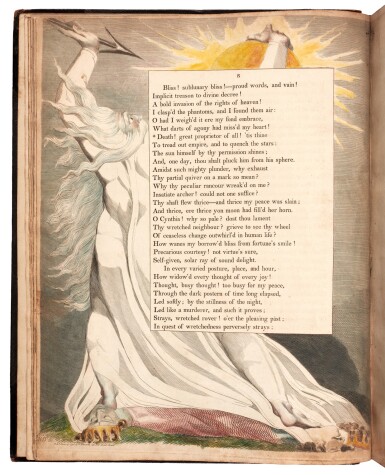
William Blake—Edward Young | The Complaint and The Consolation, 1797, with 17 hand-coloured plates
Lot Closed
July 19, 11:56 AM GMT
Estimate
20,000 - 30,000 GBP
Lot Details
Description
William Blake (Illus.)—Edward Young
The Complaint, and The Consolation; or Night Thoughts. London: R. Noble for R. Edwards, 1797
42 (of 43) full page engravings by Blake surrounding letterpress text, 17 PLATES WITH CONTEMPORARY HAND COLOURING IN CLEAR AND VIVID WASHES, WIDELY THOUGHT TO BE THE WORK OF BLAKE HIMSELF, first edition thus, large 4to, a tall copy (427 x 338mm), 19th century half black russia gilt tooled, upper cover lettered in gilt ("Young's Night Thoughts"), lacking Explanation leaf and pp. 73-74 (present in a replacement leaf with text only on different paper stock and typeface); pp. 87 and 88 repaired with loss to plates; short tears including to pp. 9-10, 73-74, 75-76, 77-78, 83-84, 93-94, 95-96; pp. 39, 62, 64, 76, 84, and 94 strengthened; some soiling and damp staining including to plates; wear and loss at spine, wear at corners
A HAND-COLOURED COPY OF BLAKE'S GREATEST COMMERCIAL PROJECT. A prospectus published early in 1797 outlined the ambitions of the project: "These engravings are in a perfectly new style of decoration, surrounding the text which they are designed to elucidate." Blake produced 537 watercolours illustrating the whole of Young's poem, far more than could ever have been used in the edition. The plan was to publish this ambitious illustrated work in four parts, beginning with this first part containing 43 engravings by Blake, based on his watercolours. However, Richard Edwards, the publisher who had commissioned Blake, closed his business after only this first part had been published.
28 hand-coloured copies of the book are known. They have conventionally been divided by style into two groups: an earlier group (of which the current copy is an example) believed to have been coloured in 1797; and a slightly later group coloured in c.1805. Two copies in the 1797 group bear early inscriptions attributing the colouring to Blake himself, allowing the colouring of the rest of the group also to be attributed to Blake. The colouring in the present copy has more variation than most other Type I copies. It shows extensive use of pink and blue tones on exposed flesh, which is found on faces in other Type I copies.
G.E. Bentley only became aware of this copy in 1975, when Blake Books (1977) was already in galley proofs, so it is not included in his list of coloured copies, but it was included in the census of coloured copies found in John Grant's 1980 edition of Night Thoughts (copy I-15), where it is described with the following note:
"Only seventeen plates are coloured, with clear and vivid washes [...] the last design having touches of greenish yellow on the plant only. On p. 4 the washes on the foliage were apparently applied before the printing was completely dried, which caused the colour to run away from the lines and produced a slightly halo effect. In general, however, the quality of the painting is superior to most Type I copies, notably I-2, the Soane copy. Many of the sheets have been creased or repaired and are dirty. Because some of the creases correspond and because there has been paint transfer from non-contiguous pages it is conjectured that these sheets may have lain undbound for some time. The binding itself, which is in poor condition, appears to have been done in the mid nineteenth century and may be the first."
The following plates are hand coloured in this copy:
frontispiece of "night the first"
p. 1: "sleep forsaking the couch of care"
p. 4: "the imagery of death variously delineated"
p. 7: "death tolling a bell"
p. 8: "the universal empire of death characterised"
p. 10: "an evil genius holding two phials"
p. 13: "We consure nature for a span too short"
p. 15: "the author encircled by thorns"
p. 19: "a skeleton discovering the first symptoms of re-animation"
p. 23: "a man measuring an infant"
p. 24: "our inattention to the progress of time"
p. 25: "time having passed"
p. 26: "the same power in his character of destroyer"
p. 27: "conscience represented as a recording angel"
p. 31: "a good man conversing with his past hours"
p. 33: "Like that, the dial speaks; and points to thee"
p. 35: "a parent communicating instruction to his family"
LITERATURE:
William Blake’s Designs for Edward Young’s “Night Thoughts,” ed. Grant et al. (Oxford, 1980), Copies of the Engraved Work no. I-15 (Previously unknown); The Blake Archive (http://www.blakearchive.org/work/bb515); G.E. Bentley, Blake Books (1977)
PROVENANCE:
Blind stamp of the Ipswich Examining Office of the Odd Fellows Manchester Unity Friendly Society ("...the duties of an Examining Officer were to examine and relieve members of the Society travelling in search of work; the members carried with them a Travelling Certificate which was embossed with the stamp in your copy. The Examining Officer in 1892 at Ipswich was James Ball - but of course I don't know whether he is YOUR examining officer...", G.E. Bentley, unpublished letter to owner, 25 June 1975 (copy included with lot)); purchased 1953 from E. Seligman by an English private collector; thence by descent
You May Also Like






![Darwin and Wallace | On the Tendency of Species to form Varieties... , [contained in:] Journal of the Proceedings of the Linnean Society, Vol. III, No. 9., 1858, Darwin announces the theory of natural selection](https://dam.sothebys.com/dam/image/lot/30891576-117d-4943-b2fa-a8ad164ee5f7/primary/extra_small)



![[Austen, Jane] | A handsome first edition of Sense and Sensibility, the author's first novel](https://dam.sothebys.com/dam/image/lot/46156b5d-366c-4a91-9f4c-de385091375e/primary/extra_small)